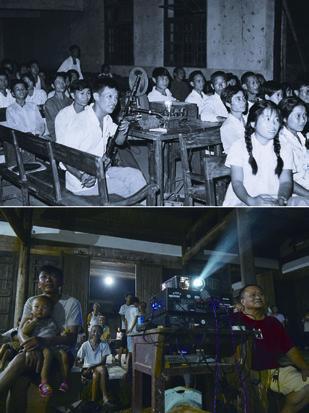THE REEL STORY
2019-11-05ByTangYuankai
By Tang Yuankai


When President Xi Jinping conferred national medals and honorary titles on 42 people on September 29 in the countdown to the 70th anniversary of the founding of the Peoples Republic of China (PRC), one of them was from the film industry.
Qin Yi, who was awarded the title of Peoples Artist, has another distinction. At 97, she is yet to hang up her acting boots. Last year, she played an inspirational woman in the film Goddesses in the Flames of War, director Jiang Pings commemoration of history with the story of a group of heroic Chinese women who defended their villages against Japanese invaders during the Chinese Peoples War of Resistance Against Japanese Aggression (1931-45).
Though dubbed the Oriental Venus by some Western media because of her striking appearance, Qin has continued to move generations of theatergoers with her portrayal of ordinary women. Medical scientist Xiu Ruijuan, founder of the Chinese Society of Microcirculation and the Asian Union for Microcirculation, once said she owed her success to Qin. When she was 12, Xiu watched Qin play a heroine who resisted the Japanese invasion and the film changed her life.
Like Xiu, the patriotic films bringing to the fore tales of courage, dedication and sacrifice during times of adversity have inspired generations and continue to do so. For instance, Children of Troubled Times, a 1935 film, gave courage to people to fight against the Japanese invasion. Directed by Xu Xingzhi, it is about the transformation of an intellectual who wavers between choosing his country and a Western lifestyle. But after the death of his friend, who had joined the Chinese resistance movement to fight the Japanese, he too joins the movement.
Every-day heroes
The first feature film made after the founding of the PRC was Bridge directed by Wang Bin, in which the working class became the protagonists of a Chinese film for the first time. During the Peoples War of Liberation (1945-49), a railroad factory in northeast China is commissioned by the Communist army to repair a bridge. Led by a skeptical engineer who does not believe the bridge can be completed in time, the factory workers lack enthusiasm and morale. However, the project is galvanized by Liang Ruisheng, who inspires his fellow workers to complete the project, a step in winning the war. Eventually, the work is completed in time and in the process, even the engineer begins to believe the war can be won.
For the film, Wang asked the actors to seek out similar figures they were to portray among ordinary people and learn about them and experience their lives before the shooting started. This kind of method acting has since become a tradition of Chinese films and artists. With Bridge, the aspirations, ability and heroism of the Chinese people became themes for the big screen, marking the adoption of realism in Chinese films.
From 1949 to 1966, a number of excellent movies hit the screen although Chinese filmmakers were embroiled in political campaigns and had to endure conflicting views and concepts. During the “cultural revolution” (1966-76), many artists were sent to rural areas for “reeducation,” where they had to do hard agricultural work. They were told that it was unclear when they would go back to making films again.
A new start
When the “cultural revolution” was over in 1976, the film industry soon recovered its momentum and new films were released.
In December 1978, the reform and opening-up policy was adopted at the Third Plenary Session of the 11th CPC Central Committee, marking the beginning of a momentous change in China. It ignited filmmakers enthusiasm.
In 1980, the Hundred Flowers Awards, which, together with the Golden Rooster Awards, are the most prestigious film awards in China, were resumed after being suspended for 17 years. Realistic films were especially in favor. In 1986, film director Xie Jins signature work Furong Zhen (Hibiscus Town) won him the Hundred Flowers Award for the best feature film, the fifth time that Xie won the award.
Based on a novel by the same name written by Gu Hua, the melodrama follows the life and travails of a young woman who lives through the turmoil of the “cultural revolution.” The film had a box-office earning of over 100 million yuan ($29 million, at then exchange rate). It meant 500 million to 1 billion tickets were sold for the film, with the ticket price varying between 0.1-0.2 yuan. In the 1980s, the film magazine Popular Movies had a circulation of over 9 million copies per month, which indicated peoples love for films.
An increasing number of Chinese filmmakers began to win prizes at international film festivals. Chen Kaiges Farewell My Concubine, the story of two men who met as apprentices in a Peking Opera troupe and whose lives were linked by vicissitudes for over 50 years, claimed the Palme dOr at the prestigious Cannes Film Festival in 1993 along with New Zealands offering The Piano. It was selected for the U.S. Academy Award as the best foreign film a year later.

The Ministry of Radio, Film and Television issued two documents in 1993 and 1994 for market-oriented reform of the film industry. The reform ended the monopoly China Film Distribution Company, which is a state-owned enterprise, enjoyed in distributing films and film studios were given autonomy to distribute the films. The reform also liberalized ticket prices.
Previously, filmmakers didnt need to worry about funding for films and their boxoffice performance. But since the reform, these have become some of the prime considerations. Also, first TV and subsequently online programs have begun to eat into the revenue of the film industry. In 1999, after the boom in TV programs, less than 300 million film tickets were sold, compared to around 29 billion before 1979.
The foreign factor
In 1994, a quota system was introduced for foreign movies screened in China. Under it, 20 foreign films were allowed to be screened in China every year, with foreign producers allowed 13 percent of the films box-office revenue. In 2012, the quota was increased to 35 films and foreign producers could claim 25 percent of the revenue.
Previously most imported movies were shown either through exchange programs for non-commercial purposes or by Chinese film distribution companies that purchased the screening rights. The introduction of more foreign films not only galvanized the sluggish Chinese cinema but also enabled domestic filmmakers to learn about the standards and operational model of foreign films and face competition.
In 2002, Zhang Yimou tried his hand at blockbusters. The period drama Hero, based on the assassination attempt on the King of Qin, who later became the first emperor who unified China in the 3rd century B.C., was released in October 2002. It had an investment of 240 million yuan ($30 million at then exchange rate), 100 times the investment of an average Chinese film at the time. It was a great commercial success, with its box-office takings surpassing 100 million yuan ($12.5 million at then exchange rate) within one week of release and total earnings that year accounting for a quarter of Chinas entire box-office revenue that year.

For a long time, a film with a box-office income of 20-30 million yuan ($2.4-3.6 million at then exchange rate) was considered successful. Now a film with a box-office taking of over 100 million yuan ($14 million) is no longer a rarity. International cooperation in filmmaking has also become more frequent. An increasing number of countries have film co-production agreements with China. Co-produced films are treated as domestic productions and are therefore not subject to the quota system, which can bring both sides better revenue. Chinese film producers are also starting to make films abroad through cooperation with overseas institutions in capital, talent, technology and market, expanding the horizon of domestic films.
A recent milestone was the Film Industry Promotion Law, which took effect in March 2017, indicating reform of the film industry had deepened.
